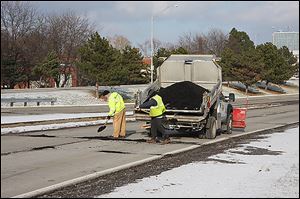
Cost-cutting blamed for travails on Trail
Lack of drainage is creating potholes
12/28/2013
A city crew patches potholes Thursday on the Anthony Wayne Trail near I-75 on the approach to downtown Toledo.
Eleven years ago, the city of Toledo saved $1.9 million by eliminating drainage upgrades from a resurfacing project on the Anthony Wayne Trail.
Now, that paving job is falling apart, and city crews may have to grind parts of it down to the previous surface to soften bumps that have formed when pavement chunks peeled away early this week during a particularly brutal pothole outbreak.
Crews on Thursday patched dozens of peel-away holes, but how long those repairs — made with cold asphalt mix because hot mix isn’t available in the winter — will hold up is uncertain.
David Pratt, the city’s commissioner of streets, bridges, and harbor, said permanent repairs for big chunks that have gone missing, from the Maumee city line to Collingwood Boulevard, are difficult because of their size.
Most holes are shallow — only a couple inches deep, matching the thickness of pavement applied to the roadway in the late summer and early fall of 2002 — so they’re unlikely to burst anyone’s tires or destroy automobiles’ suspensions the way deeper street craters do.
Because of their size, the typical pothole cure of shoveling cold-patch in and then tamping the hole is ineffective for repairing many of the Trail’s gaps.
Mr. Pratt said crews had to use rollers to pack down the material and smooth the surface.
While the city is developing plans to rebuild the Trail several years from now, it doesn’t have the money for extensive stopgap repairs between now and then, Mr. Pratt said.
If necessary, he said, a temporary solution could be to mill the newer pavement at the trouble spots, effectively creating ramps down to the previous pavement and back.
That would make the ride something of a roller coaster, but not as jarringly bumpy as it would be if nothing were done at all.
Why the pavement is peeling away — in technical terms, delaminating — is something the streets commissioner said he couldn’t explain, noting that he wasn’t involved when the city repaved the Trail in 2002.
But this isn’t the first winter to play havoc with the Trail’s pavement, and a city consultant determined 9½ years ago that the 2002 project’s cost-cutting was likely a factor when problems arose during the winter of 2003-04.
City officials originally expected that Trail resurfacing project would cost about $3.8 million.
But by eliminating curb replacement, subsurface drains, and other drainage improvements from the contract, its cost was cut in half, and Ohio Department of Transportation funding covered 80 percent of the balance.
That left the city with a bill for less than $400,000 to repave slightly more than 8¼ miles of six-lane roadway.
But less than two years later, a city consultant found that cutting the drainage work out of the project had made the roadway more vulnerable to moisture-related problems, particularly frost heaves that affected old concrete-slab pavement underlying the roadway’s asphalt layers.
But in January, 2004, an extended cold snap even deeper than the 13-day freezing spell that settled over Toledo early this month caused old concrete slabs beneath the pavement to heave upward, creating bumps all along Toledo’s portion of the Trail.
The slabs gradually settled in February and March, leaving cracks that the city sealed.
In a report issued the following spring, consultant TTL Associates Inc. of Toledo found no fault with the paving done by Miller Brothers Construction.
The consultant said the contractor was not responsible for the concrete slabs’ condition or other problems believed to have contributed to the heaves.
Instead, the consultant said cutting the drainage work from the project’s cost was a likely cause for the frost heaves.
Installation of an irrigation system in the Trail’s median just before the resurfacing project, along with rainfall during construction, could have introduced moisture between the pavement layers, too, the consultant said.
“The city does know and understand that the Anthony Wayne Trail is cycling into a period where it will be necessary to do work,” said Steve Day, a section leader at the Division of Engineering Services.
City engineers have been exploring project options, including the availability of grants that might cover a significant amount of construction costs, Mr. Day said.
But for now, the only Trail-related project that has a tentative timeline is the section immediately around I-75.
The Ohio Department of Transportation plans to overhaul that portion of the Trail as part of rebuilding I-75 through downtown Toledo.
That construction is scheduled for 2016 through 2018.
Any major work on the rest of the Trail, Mr. Day said, is likely to be broken down into multiple contracts.
“Because of the scale, it’s likely to occur in phases and require funding from multiple sources,” he said.
Contact David Patch at: dpatch@theblade.com or 419-724-6094.